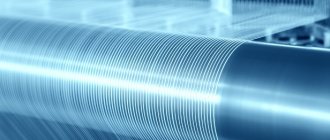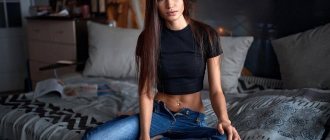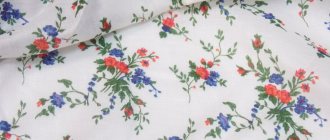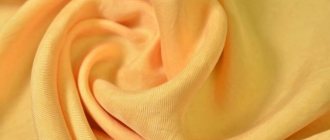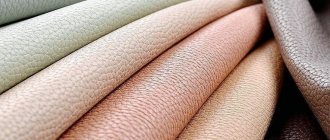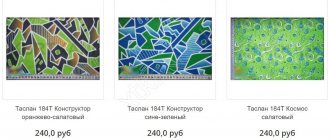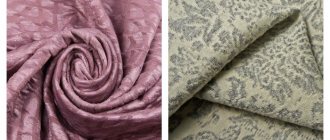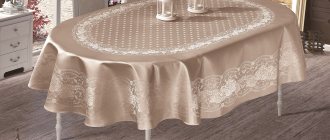What is it: bouclé fabric
The canvas first appeared in the 20s of the last century in France. The famous Coco Chanel did not ignore bouclé fabric. She staged a show with women's business suits. But the idea did not take root due to the irrelevance of the official style among girls.
Later, in 1954, Chanel, confident in the success of the concept, risked repeating the experiment with jackets and skirts. And she turned out to be right, the costumes impressed with their elegance and simplicity, and the material very quickly turned from unknown to iconic.
In the 60s, it began to be used for sewing dresses and jackets; later, in the 70s, the first boucle coats appeared.
The textile itself is a soft, loosely woven fabric with loops of fibers over the entire surface. It looks voluminous but elegant. Therefore, it is not advisable to overload outfits containing bouclé material with details.
The fabrics are made from fancy or crepe twisted yarn. The weaving is based on fibers with loops and knots. This gives them a characteristic relief.
The plain weave of the fibers is loose and loose, but the fabric is quite strong and stretches well. The elasticity of the material depends on the amount of synthetic fibers in the composition. The more natural threads, the better it stretches.
In addition to plain weave, patterned weave is also woven. For it, colored threads are usually used, which form various patterns.
View this post on Instagram
Posted by Fashion Fabric Boutique (@taylors__home) Jan 10, 2021 at 11:58 PST
Most often in the manufacture of canvases they use:
- Wool yarn. It protects against cold and is wear-resistant. The thickness of bouclé wool depends on the density of the fibers.
- Cotton, silk, giving gloss, elegance and softness.
- Viscose threads, polyester. Weaved for greater strength.
When purchasing, you should consider the ratio of synthetic and natural fibers. Bouclé, made entirely of synthetics, will not allow the skin to breathe.
If the material is made entirely of natural threads, there should be a lining inside.
To see what the fabric looks like:
Description of fabric
The bouclé material, similar in appearance to astrakhan fur, is soft and pleasant to the touch. Despite the apparent volume and bulkiness, the fabric is light and elastic. The unusual rough surface of the canvas is obtained as a result of original production technology. Bouclé is made in plain weave from thick fancy or crepe yarn.
In the weaving of any fabric, two threads are involved: lobe and weft. The first of them forms the basis of the fabric and runs parallel to the edge, the second thread, otherwise known as the weft, is laid perpendicular to the main one. When making bouclé, one of the threads, lobe or weft, has knots or knobs located at an equal distance from each other. They create an intricate surface relief.
Sometimes you can find a denser bouclé, which is made using patterned weaving from multi-colored threads. The most popular of the patterns is the famous “chicken foot” or “houndstooth”. Materials can be plain, melange, checkered and striped.
Advantages and disadvantages of the material
The fabric is especially popular in high fashion because of the following advantages:
- volume, relief;
- retains heat and allows the skin to breathe;
- pliable for draping, elastic;
- practically does not wrinkle, you do not need to iron it often.
The disadvantages include the following:
- The canvas is quite difficult to work with. When cut, it crumbles and wrinkles badly.
- Over time, pellets and unnecessary loops form on the surface.
- The material is not suitable for everyone. For example, it gives extra volume to plump women.
Material composition
Woolen boucle turned out to be the most popular among clothing manufacturers, and the thickness of the material directly depends on the percentage of wool included in the fabric. Materials made from cotton, viscose, and silk are in great demand. Bouclized polyester is used as upholstery in furniture making.
Types of bouclé
Types of canvas vary in color and density. Most often, canvases are classified according to the nature of the ornaments and color scheme:
- patterned;
- melange;
- plain.
Textiles can contain natural and synthetic fibers in different proportions:
- Natural silk, cotton, linen threads add solemnity and sophistication to the material.
- Synthetic ones make them brighter and catchier.
The most common type of bouclé is mixed.
View this post on Instagram
Publication from Yarn Rostov-on-Don. (@igolka_beloshveika) Oct 3, 2019 at 3:23 PDT
Advantages and disadvantages
Like any material, boucle has its pros and cons, which are important to consider when sewing garments, as well as when caring for finished products.
Pros:
- natural fabric base;
- ease;
- softness;
- ability to warm in cold weather;
- protects from wind and rain;
- spectacular appearance;
- a wide range of fabrics in different colors;
- The material is quite easy to work with when sewing and cutting.
Minuses:
- the need for careful processing of sections, as the fabric frays a lot;
- if handled carelessly, puffs may appear;
- The density of the fabric can add unnecessary volume to the figure.
Products made from woolen fabric look especially voluminous. The thinnest types of bouclé are silk and viscose fabrics.
Scope of application of the material
Boucle is quite warm, but at the same time light material. It is often used for sewing outerwear, such as coats or hats. Jackets and warm suits are made from it.
Natural fabric allows air to pass through and allows the body to breathe. Therefore, it is often used to make summer clothes or business suits. These can be a variety of dresses, skirts or knitwear made from thin bouclé.
When creating an image with wardrobe elements made from bouclé fabric, keep in mind that you cannot use too many accessories. This will overload it, make it too colorful and bulky.
It is best to combine light-colored items in pastel colors with the material. For example, a white blouse, stretch trousers and a clutch in the left hand to complete the look will go perfectly with a bouclé jacket.
The material is often used for interior decoration. Curtains and furniture covers are made from it.
View this post on Instagram
Publication from women's clothing store (@odessa_shop_vl) January 9, 2020 at 4:55 PST
View this post on Instagram
Publication from Odyag&vzuttya Lviv (@o_beauty_store) January 12, 2020 at 1:54 PST
Where is it used?
The scope of use of bouclé depends on the density and composition of the material.
Sewing clothes and hats
The original purpose of the fabric is to manufacture items for men’s and women’s wardrobes:
- Thick, voluminous boucle is used for sewing coats and winter suits. Coat material can be pure wool or with the addition of polyester and elastane. It differs from drape in its lighter weight and sparse structure.
- Suit fabric is thinner, with a less convex surface. Can be made from pure wool or synthetics. But more often it is produced in mixed composition. Used for sewing women's suits, jackets, cardigans, skirts, winter dresses. Also popular for sewing men's jackets.
- Dress bouclé is a lightweight fabric woven from cotton, viscose, with the addition of silk and elastane. Available mainly in pastel shades. It can be plain colored or with a pattern in the form of a cage or stripes.
- Bouclé with natural silk additives is the most expensive and exquisite material. Top-class summer clothes are made from it.
bouclé skirt
bouclé jacket
bouclé jackets
bouclé cardigan
As for headwear, boucle is a popular material for sewing caps, berets, and hats. Depending on the season, coat or suit fabric is used. The material is combined with leather, shaded with smooth fabrics, decorated with metal fittings and embroidery.
Furniture reupholstery
Boucle is a popular upholstery material for chairs, sofas, armchairs, and poufs. Consists mainly of synthetic fibers: polyester and acrylic. It has a high density - 350-600 g/m2. According to the abrasion test, it can withstand about 40 thousand cycles (the norm is 20 thousand).
In addition to its stylish appearance, bouclé furniture fabric has other advantages:
- Hypoallergenic: does not cause a negative reaction in the body.
- Versatility: suitable for all types of upholstered furniture, including frameless.
- Air permeability: furniture material ensures ventilation of internal parts and components, prevents the formation of condensation, which has a beneficial effect on their working condition.
- Non-oriented drawing: the possibility of economical cutting of parts.
- Easy to care for: the upholstery can be easily cleaned with a vacuum cleaner or brush.
Bouclé curtains
Curtain fabric is made primarily from polyester. It can be regular or blackout, plain or with a pattern. Often available with a lining.
Draps well and can be used for sewing decorative pillows and bedspreads.
Caring for boucle fabric
To keep things looking neat longer, follow the rules for caring for bouclé:
- Dirt from woolen fabric should be removed with a soft brush or taken to dry cleaning. It shrinks with normal washing.
- The material, made primarily of synthetics, can be washed at home on a delicate cycle without spinning. Water temperature no more than 40 degrees.
- Loose fabrics are best washed separately in a mesh bag. Don't forget to fasten the buttons first. This will help prevent puffs from occurring.
- To dry the fabric, it must be placed on a flat surface, straightened out from folds and creases.
- Iron the fabric right side inward. It is recommended to set the temperature to 130 degrees. While doing this, try to apply gentle pressure on the fabric.
See an overview of how to work with fabric:
Super properties and disadvantages of bouclé knitwear
Knitted material with a knotted surface appeared later than fabric and quickly won many fans.
Its advantages:
- Aesthetics: bouclé looks impressive and stylish.
- Lightness: thanks to the porous structure, knitwear weighs little.
- Softness: the material is pleasant to the touch and to the body.
- Plasticity: knitwear fits well and drapes.
- Air permeability: due to free access of air to the body, increased sweating is eliminated.
- Protection from the cold: bouclé retains heat perfectly.
- Wrinkle resistance: knitwear retains its shape when worn.
- Convenient to sew: the material is great for beginner seamstresses, since the textured surface hides uneven stitches well.
As for the disadvantages of knitwear, there are few of them:
- Susceptibility to tightening due to loose structure.
- It crumbles on cuts, so when sewing you need to make large allowances or immediately process it with an overlocker or bias tape.
- Gives volume to the figure, making it visually heavier.
Cost of bouclé
Boucle is an expensive fabric. The price will vary depending on the type of fabric, but stores mainly sell items at the following prices:
- jacket - from 4,000 rubles;
- coat - about 10,000 rubles;
- trousers, skirts – from 2,000 rubles;
- dresses – 5000–6000 rubles.
When choosing clothes, it is better if the brands are familiar to you. These include:
- Chanel - France;
- Asos – Asia;
- Mango – Asia;
- Dolce & Gabbana – Italy;
- H&M – Asia;
- ZARA – Asia, Portugal, Spain;
- Marks & Spencer - Asia.
The yardage of bouclé in textile stores has the following cost:
- 500 rubles per meter of pure synthetics;
- from 800 rubles for semi-synthetic fabric;
- about 1500 rubles for natural.
Application
Women's and men's jackets, coats, and vests are made from soft boucle coat fabric (wool and cotton). Such things look elegant, retain heat well and emphasize the dignity of the figure. During the demi-season, you can often see passers-by on the street dressed in warm knotted clothes, for example, Chanel-style jackets made of warm bouclé.
Bouclé dress fabric is thinner than coat fabric. Jackets, skirts, dresses, trousers, berets and other wardrobe items are sewn from it.
Bouclé furniture fabric is often synthetic. It is used to make upholstery for sofas and armchairs, removable covers, cushion covers, and even bedspreads are made from soft bouclé.
The world of curtains also did not go unnoticed by knotted fabric. The curtains are dense, provide good protection from excess light and are pleasant to look at.
Expensive summer clothes for adults and children are made from the finest silk and viscose bouclé.
Sofa upholstered in bouclé fabric
Reviews
Buyers note that the bouclé has an unusual appearance. Despite the difficulties in caring for the fabric, most users are satisfied with the choice and leave positive reviews about it:
Marina
“I fell in love with the booklet at first sight when I was choosing a coat a couple of years ago. It looks very stylish, the natural wool in the composition helps not to freeze in the cold. The only thing you can’t wash at home is that you have to pay money for dry cleaning. But what can you do, beauty requires sacrifice.”
Antonina
“I wear a bouclé jacket to work. I bought it on the market a few months ago. The fabric is half synthetic, but I knew what I was getting into. It was important that there was no hassle in maintenance. Overall I’m happy, the main thing is to make sure that nothing gets caught in the fabric, otherwise there will be a tightening.”
Recommendations for care and storage of products
Boucle is a fairly practical and easy-to-care fabric if you know how to wash and clean it correctly. First of all, you need to focus on the features of the composition:
- Woolen bouclé does not tolerate machine washing well, so the products should only be dry cleaned. At home, basic care involves regularly removing dust with a brush. In this case, you should act with caution so as not to overextend.
- Wool-blend bouclé with synthetic additives can be washed by hand or on a delicate cycle in a machine. Water temperature – up to 30°C. Soaking and keeping in water for a long time is prohibited; spinning and drying in a drum are also contraindicated. Store in well-ventilated places, protected from sunlight, away from heat sources.
- Boucle made of synthetics and artificial materials can be washed by hand and machine (on a delicate cycle) at temperatures up to 40-60 °C. It is forbidden to twist or squeeze too hard. It is recommended to dry in a horizontal position on a soft substrate.
- Natural silk fabric: wash in cool water. Spinning is prohibited.
It is allowed to iron bouclé items only from the wrong side with a warm iron, barely touching.
Advice! To preserve the texture of the material, it is recommended to iron things on a terry towel.
Tips for sewing with bouclé
If you sew clothes yourself and this time chose boucle when choosing fabric, take note of some nuances of working with it:
- When cutting, the fabric must be processed with an overlocker, otherwise it will crumble.
- When working with material made from natural fibers, you should use a lining. This way it will retain its shape and neat appearance longer.
In addition, see how to sew items from fabric:
Bouclé is a textured fabric popular in the world of high fashion. When combined correctly, it will help emphasize the figure and add volume in places where it is lacking. Bouclé is distinguished by its variety of types; natural and synthetic fibers are often combined in the fabric.
Do you have boucle items in your wardrobe? What would you suggest other users pair them with? Share your opinion in the comments and repost.
Tips for choosing
Bouclé material is popular in many areas, so it is not surprising that many fakes have appeared. High-quality textiles can be distinguished by several characteristics.
Determining the quality of boucle in clothes
Elite fabrics cannot be cheap, so the higher the quality of the material, the more expensive it will cost.
You also need to pay attention to:
- weaving density: when held to light, the bouclé should be uniform;
- susceptibility to the formation of puffs: in high-quality fabric, the nodules should be the same;
- composition: the percentage of fiber content is indicated in the description. The more natural fibers, the better the bouclé;
- elasticity: after creasing, the texture should quickly recover without forming creases.
When determining quality, tactile sensations should also be checked. If the bouclé feels hard to the touch, wrinkles easily, stretches or becomes electrified, then these are signs of poor quality.
We select wear-resistant material for interior decoration
When choosing a fabric, it is necessary to proceed from its intended purpose. If it is needed for reupholstering furniture, then you should prefer a material with a high density - about 600 g/m2. Bouclé chenille or corduroy have these characteristics.
Curtains, pillows and bedspreads can be sewn from bouclé of lower density. Items made from bouclé fur will also decorate the interior well. The fabric with pronounced curls is made entirely of synthetics, therefore it retains the decorative effect and structure of the material for a long time and is easy to care for.
The difference between elite silk bouclé and cheap analogues
The main sign by which you can recognize natural silk is a subdued shine that changes color depending on the lighting. Artificial material does not have this property: the shade remains unchanged and looks the same in any light.
A more reliable result can only be achieved experimentally.
To do this, you need to pull out the thread and set it on fire, then analyze the result:
- Natural silk burns slowly and smells like burnt wool or burnt feathers.
- Synthetics: melts and forms a dense lump at the end that smells like burnt plastic.
- Artificial silk (viscose): burns quickly, smells like burnt paper, crumbles under your fingers.
Wearing a bouclé
Clothes made from bouclé yarn can be both elegant and casual. Some believe that a stylish tweed jacket is ideal for the professional woman who wants to look and feel successful. The soft texture of bouclé yarn adds a feminine touch, allowing for a conservative, understated look that is still accessible and modern.
